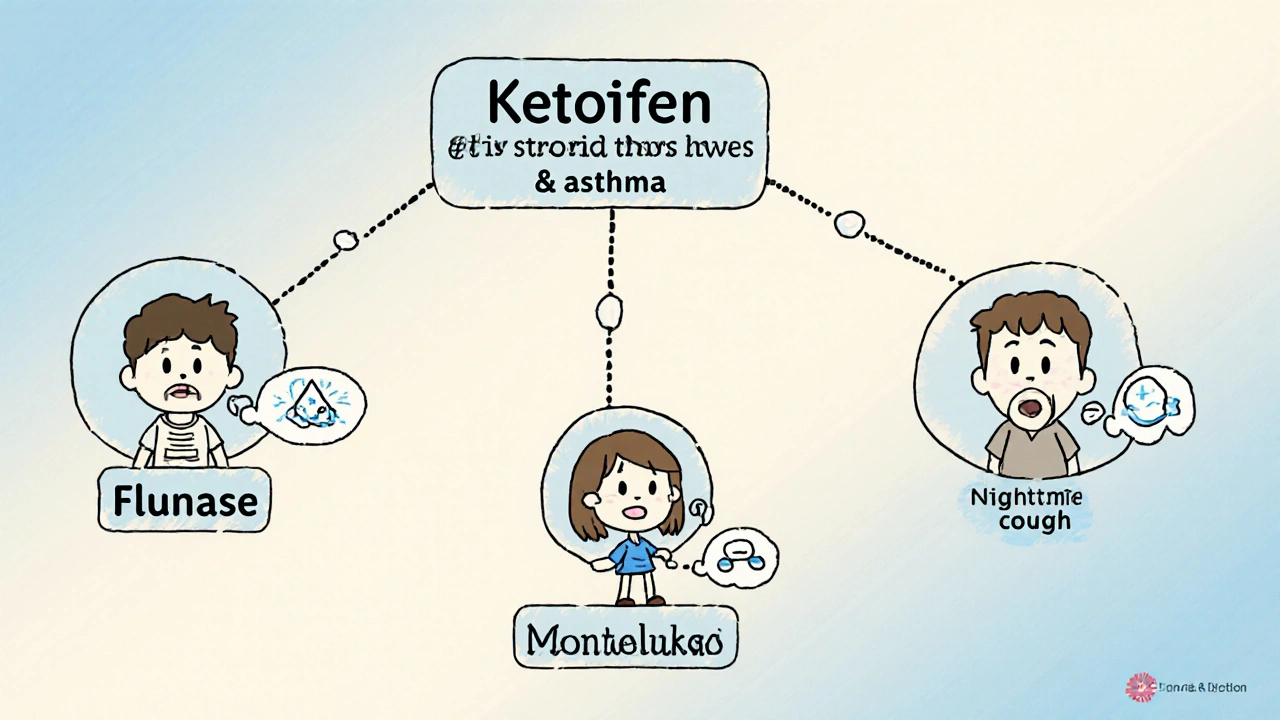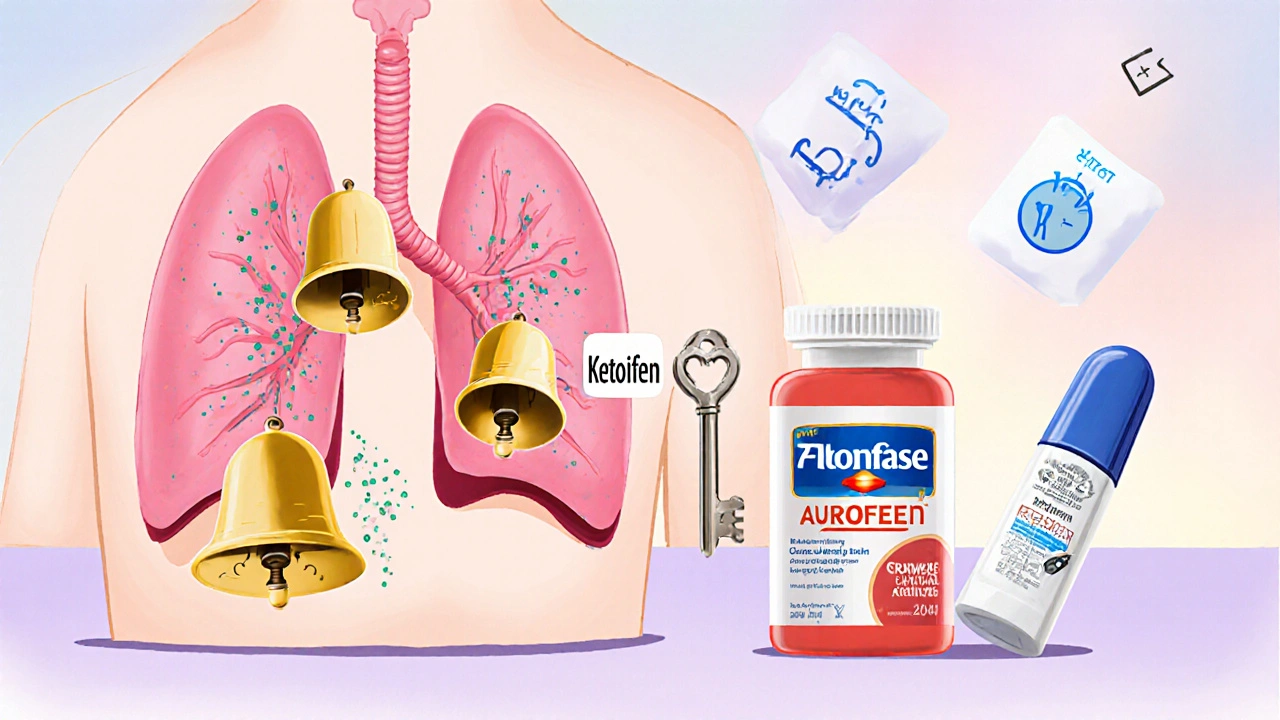Allergy & Asthma Medication Finder
Find the Right Allergy & Asthma Medication for You
Answer a few questions about your symptoms to get personalized recommendations based on medical research
Your Primary Symptoms
Symptom Duration
Your Age Group
Your Treatment Preferences
If you're taking Ketotifen for allergies or asthma, you've probably wondered if there's something better-or at least different-that might work for you. Maybe your doctor prescribed it, or you found it online. But now you're wondering: is Ketotifen the best option? Are there other pills, sprays, or treatments that do the same job without the side effects?
Ketotifen isn't a household name like Zyrtec or Claritin. It's a mast cell stabilizer, not a typical antihistamine. That means it works differently. Instead of just blocking histamine after it's released, Ketotifen stops mast cells from releasing histamine in the first place. This makes it useful for long-term control, especially in allergic asthma and chronic urticaria. But it's not approved everywhere. In the U.S., it's not available by prescription. In Australia, it's sold under brand names like Zaditen, but only with a doctor's note. In Europe and parts of Asia, it's more common.
How Ketotifen Actually Works
Ketotifen belongs to a class called mast cell stabilizers. Think of mast cells as tiny alarm systems in your body. When they sense allergens-like pollen, dust mites, or pet dander-they release histamine and other chemicals. That’s what causes itching, swelling, runny nose, and wheezing.
Most allergy meds, like cetirizine or loratadine, act like a mute button on histamine after it’s already been released. Ketotifen is more like turning off the alarm before it rings. It stops mast cells from exploding with chemicals. That’s why it’s often used for prevention, not instant relief.
It also has mild antihistamine effects, so it does both jobs: blocks histamine and prevents its release. This dual action makes it unique. But it takes time to work. You won’t feel better right away. Most people notice improvement after 2-4 weeks of daily use.
Common Ketotifen Alternatives
Since Ketotifen isn’t widely available everywhere, people often look for similar options. Here are the most commonly used alternatives, broken down by how they work and who they’re best for.
1. Cromolyn Sodium (Intal, Nasalcrom)
Cromolyn sodium is the closest cousin to Ketotifen. Like Ketotifen, it’s a mast cell stabilizer. It’s available as a nasal spray and inhaler. It’s safe for kids and pregnant women. But it needs to be used 3-4 times a day, every day, to work. Miss a dose, and protection drops fast.
It’s great for mild seasonal allergies or exercise-induced asthma. But if your symptoms are moderate to severe, it won’t cut it alone. Many people use it alongside an antihistamine or steroid spray.
2. Montelukast (Singulair)
Montelukast is a leukotriene receptor antagonist. It blocks different chemicals than histamine-leukotrienes-that cause airway tightening and mucus buildup. It’s taken as a daily pill, often at night. It’s FDA-approved for asthma and allergic rhinitis in adults and children as young as 6 months.
Studies show Montelukast works well for nighttime asthma symptoms and allergic congestion. It doesn’t help with itchy eyes or runny nose as much as antihistamines do. But for people with asthma triggered by allergies, it’s a solid choice. Side effects are rare but can include mood changes-something to watch for, especially in teens.
3. Loratadine (Claritin) and Cetirizine (Zyrtec)
These are second-generation antihistamines. They’re non-drowsy, widely available over the counter, and start working within an hour. They’re perfect for quick relief of sneezing, itching, and runny nose.
But here’s the catch: they don’t touch asthma. If you have allergic asthma, antihistamines alone won’t prevent wheezing. That’s why Ketotifen or Cromolyn might be better for long-term control. Still, many people combine them. For example: take Zyrtec for daytime symptoms and Ketotifen at night to prevent flare-ups.
4. Fluticasone Nasal Spray (Flonase)
This is a corticosteroid spray. It reduces inflammation in the nasal passages. It’s the gold standard for persistent allergic rhinitis. It takes 3-7 days to kick in, but once it does, it’s powerful.
Flonase doesn’t help with wheezing or skin reactions like hives. But if your main problem is nasal congestion, post-nasal drip, or sinus pressure, it’s often more effective than Ketotifen. Many doctors prescribe it alongside a mast cell stabilizer for full coverage.
5. Omalizumab (Xolair)
This is an injectable biologic for severe allergic asthma. It targets IgE antibodies-the body’s main alarm signal for allergens. It’s not for mild cases. It’s expensive, requires monthly shots, and is only for people who still have symptoms despite using high-dose inhalers and other meds.
If you’ve tried Ketotifen, Montelukast, and steroid sprays and still struggle with asthma attacks, Omalizumab might be your next step. But it’s not a first-line alternative. It’s a last-resort option.
Which Alternative Is Right for You?
Choosing between Ketotifen and its alternatives depends on your symptoms, how fast you need relief, and what’s available where you live.
Here’s a quick guide:
| Medication | Form | Onset of Action | Best For | Limitations |
|---|---|---|---|---|
| Ketotifen A mast cell stabilizer with mild antihistamine effects, used for allergic asthma and chronic hives | Tablet | 2-4 weeks | Long-term asthma control, chronic urticaria | Not available OTC in many countries; drowsiness possible |
| Cromolyn Sodium Mast cell stabilizer used as nasal spray or inhaler | Nasal spray, inhaler | 2-4 weeks | Mild allergies, exercise-induced asthma | Must be used 3-4 times daily; ineffective for acute symptoms |
| Montelukast Leukotriene blocker for asthma and allergic rhinitis | Tablet | 24 hours | Nighttime asthma, allergy-related congestion | Potential mood side effects; doesn’t help skin symptoms |
| Cetirizine Second-generation antihistamine for allergic symptoms | Tablet | 1 hour | Sneezing, itching, runny nose | No effect on asthma; can cause drowsiness in some |
| Fluticasone Nasal corticosteroid for inflammation | Nasal spray | 3-7 days | Chronic nasal congestion, post-nasal drip | No effect on wheezing or hives |
If you have mild allergies with occasional wheezing, Cromolyn might be enough. If your nose is constantly stuffed, Flonase is probably your best bet. If you have asthma that flares up at night, Montelukast is a solid choice. If you’re looking for something that prevents both skin and lung reactions over time, Ketotifen still holds value-especially if you can get it.

What Ketotifen Can’t Do
Ketotifen isn’t a cure-all. It won’t stop an asthma attack in progress. It won’t relieve sudden hives. It’s not meant for emergency use. If you need fast relief, you’ll still need a rescue inhaler like albuterol or an antihistamine like Benadryl.
Also, it can cause drowsiness. Not everyone gets it, but enough people do that it’s worth noting. If you drive or work with machinery, test it on a weekend first. Some people take it at night to avoid daytime sleepiness.
And while it’s generally safe, it’s not for everyone. People with liver disease or those on other sedating meds should talk to their doctor first.
When to Consider Switching
You might want to switch from Ketotifen if:
- You’re not seeing improvement after 6 weeks
- You’re experiencing drowsiness that affects your daily life
- You can’t get it reliably in your country
- Your symptoms are getting worse despite daily use
Don’t stop Ketotifen cold turkey. Talk to your doctor. They might suggest tapering it while starting a new medication.

Real-World Use Cases
Here are three common scenarios:
- Case 1: A 10-year-old with seasonal asthma and hives - Starts on Ketotifen. After 3 weeks, hives improve, but nighttime cough lingers. Doctor adds Montelukast. Symptoms stabilize.
- Case 2: A 35-year-old with chronic nasal congestion - Tried Zyrtec, but nose stays stuffed. Switches to Flonase. No more post-nasal drip, better sleep.
- Case 3: A 50-year-old with exercise-induced wheezing - Uses Cromolyn inhaler before workouts. No attacks. No need for daily pills.
There’s no one-size-fits-all. What works for one person might not work for another-even with the same diagnosis.
Final Thoughts
Ketotifen is a quiet hero in allergy and asthma treatment. It doesn’t get the spotlight like newer drugs, but for some people, it’s the missing piece. It’s not flashy, but it’s reliable. If you’ve tried everything else and still have unexplained symptoms, it might be worth asking your doctor about it-especially if you live where it’s available.
But if you’re looking for fast relief or you’re in a country where Ketotifen isn’t sold, you have solid alternatives. The key is matching the medicine to your symptoms-not just picking the most popular one.
Track your symptoms. Keep a journal. Note when you feel better, worse, or unchanged. That’s the best way to find what works for you.
Is Ketotifen better than Zyrtec for allergies?
It depends on your symptoms. Zyrtec (cetirizine) works fast for sneezing, itching, and runny nose. Ketotifen doesn’t help as quickly, but it prevents symptoms over time and can help with asthma. If you only have nasal allergies, Zyrtec is easier and faster. If you have asthma or chronic hives, Ketotifen may be more effective long-term.
Can I take Ketotifen with other allergy meds?
Yes, many people combine Ketotifen with antihistamines like loratadine or nasal steroids like Flonase. But avoid combining it with other sedating medications-like Benadryl or certain sleep aids-because Ketotifen can cause drowsiness. Always check with your doctor before mixing meds.
Why isn’t Ketotifen available in the U.S.?
The FDA never approved Ketotifen for general use in the U.S., though it was briefly available in the 1980s. The reasons aren’t fully public, but it likely had to do with market competition and the rise of newer antihistamines. It’s still used in other countries and can sometimes be imported with a prescription for special cases.
Does Ketotifen help with eczema?
Some studies show Ketotifen can reduce itching and flare-ups in atopic dermatitis (eczema), especially when it’s linked to allergies. It’s not a first-line treatment, but for people whose eczema worsens with allergen exposure, it can help reduce overall inflammation. Topical versions exist in some countries, but oral Ketotifen is more common.
How long should I take Ketotifen before deciding if it works?
Give it at least 4 to 6 weeks. Because it works by preventing mast cells from releasing chemicals, not by blocking them after release, it takes time to build up in your system. If you don’t notice improvement after two months, talk to your doctor about switching or adding another treatment.







Patrick Klepek
October 31, 2025 AT 20:11Ketotifen’s underrated. Most people chase the quick fix, but this thing? It’s the quiet guy in the back who actually keeps the party from burning down. Took me 5 weeks to notice, but my asthma flares dropped 80%. No drowsiness either. Weirdly, it’s like my body finally stopped panicking.
Caden Little
November 1, 2025 AT 12:46Big +1 to Patrick. I’ve been on Ketotifen for 8 months now. Combined it with Flonase and it’s been life-changing. No more midnight coughing fits. Side note: if you’re drowsy, take it at night. Also, don’t skip doses - it’s not a ‘when I feel like it’ med. Consistency is everything. 💪
Jim Aondongu
November 2, 2025 AT 13:17Why is everyone acting like Ketotifen is some secret weapon? In Nigeria we’ve had it for decades. It’s just a cheap mast cell stabilizer. The real issue is pharma companies pushing expensive alternatives so you keep buying. Wake up. This isn’t medicine, it’s capitalism.
Michael Schaller
November 3, 2025 AT 22:22I used to think Montelukast was the answer until I started having nightmares. Switched to Ketotifen. No dreams. No anxiety. Just steady breathing. Took a month. Worth it.
Kurt Stallings
November 4, 2025 AT 23:20Of course Ketotifen works. It’s the only drug that doesn’t pretend to be a superhero. Zyrtec? A glorified nap. Flonase? Just spraying steroids into your nose like a toddler with a water gun. Ketotifen? It’s the only one that actually respects your biology. The FDA banned it because it doesn’t make enough money. End of story.
Angie Creed
November 5, 2025 AT 07:04There’s a metaphysical truth here: medicine has forgotten how to be patient. We want instant relief, so we’ve abandoned prevention. Ketotifen doesn’t scream-it whispers. And in a world of noise, the whisper is the most radical act. Mast cells aren’t enemies. They’re messengers. Ketotifen doesn’t silence them. It teaches them to speak softly. The FDA? They’re still screaming.
Kyle Tampier
November 6, 2025 AT 18:56THEY DON’T WANT YOU TO KNOW THIS! Ketotifen was banned in the U.S. because Big Pharma bribed the FDA to kill it! They’ve got a monopoly on Zyrtec and Flonase! I saw a whistleblower video on Telegram-there’s a whole secret dossier! Check the FDA’s 1987 meeting minutes-redacted for a reason! Don’t trust your doctor-they’re paid!
Tom Caruana
November 7, 2025 AT 03:50OMG I’ve been on Ketotifen for 3 weeks and my skin is glowing?? Like literally?? I had eczema since I was 5 and now I’m not scratching my arms raw?? I’m crying rn 😭😭😭 also can I take it with my CBD gummies?? I feel so seen!!
Manish Mehta
November 8, 2025 AT 05:57I tried Ketotifen after my doctor said no other thing worked. Took two weeks. My breathing got better. Not magic. Just better. I still use my inhaler when needed. Simple. No drama. Works.
Sarah Cline
November 8, 2025 AT 20:39Just wanted to say thank you to everyone who shared their stories. I’ve been scared to try Ketotifen because I thought it was too obscure. But reading this? Made me feel less alone. I’m starting it next week. Fingers crossed! 🤞
Michael Ferguson
November 8, 2025 AT 23:55Let’s be real here-Ketotifen isn’t some miracle cure. It’s a 1970s drug that survived because it’s cheap and works for a niche group. But the reason it’s not FDA-approved isn’t some conspiracy-it’s because the clinical trials didn’t show significant advantage over existing drugs in large populations. You’re not a rebel for using it. You’re just one of the 2% of people who respond well to it. And that’s fine. But don’t pretend you’ve cracked some medical code. Your anecdote isn’t data. And your suffering doesn’t invalidate the regulatory process. Also, if you’re taking it with CBD, you’re risking liver toxicity. Please stop.
Sebastian Brice
November 10, 2025 AT 05:59Michael, I hear you. But you’re missing the point. People aren’t celebrating Ketotifen because they think it’s perfect. They’re celebrating it because for once, someone listened. No one told them, ‘just take Zyrtec and tough it out.’ They found something that actually fits their body. That’s not ignorance-that’s self-advocacy. And yeah, maybe it’s not for everyone. But that’s why we have options. Not every drug needs to be a blockbuster to be valuable.
Muzzafar Magray
November 11, 2025 AT 17:25You all sound like you’re on a cult retreat. Ketotifen is not special. It’s just another drug with side effects. I’ve seen people in India take it and still end up in the ER because they ignored their asthma. Don’t romanticize medicine. It’s chemistry, not enlightenment. And if you’re using it with CBD? You’re playing Russian roulette with your liver.
Renee Williamson
November 12, 2025 AT 07:43So like… Ketotifen is basically the ‘quiet girl’ of allergy meds? And everyone’s like ‘she’s so underrated’? I just want to know if it makes you sleepy like Benadryl or if it’s more like ‘I’m just gonna nap for 3 hours after dinner’ vibes? Asking for a friend who’s scared to try it 😅
Caden Little
November 12, 2025 AT 13:40@Renee Williamson-yes, it’s like Benadryl but slower and less intense. For me, it’s a 20% drowsiness boost around 8 PM. I take it at 7:30, watch a show, and by 9 I’m out. No grogginess next day. If you’re sensitive to meds, start with half a pill. Don’t be afraid. You got this. 💛